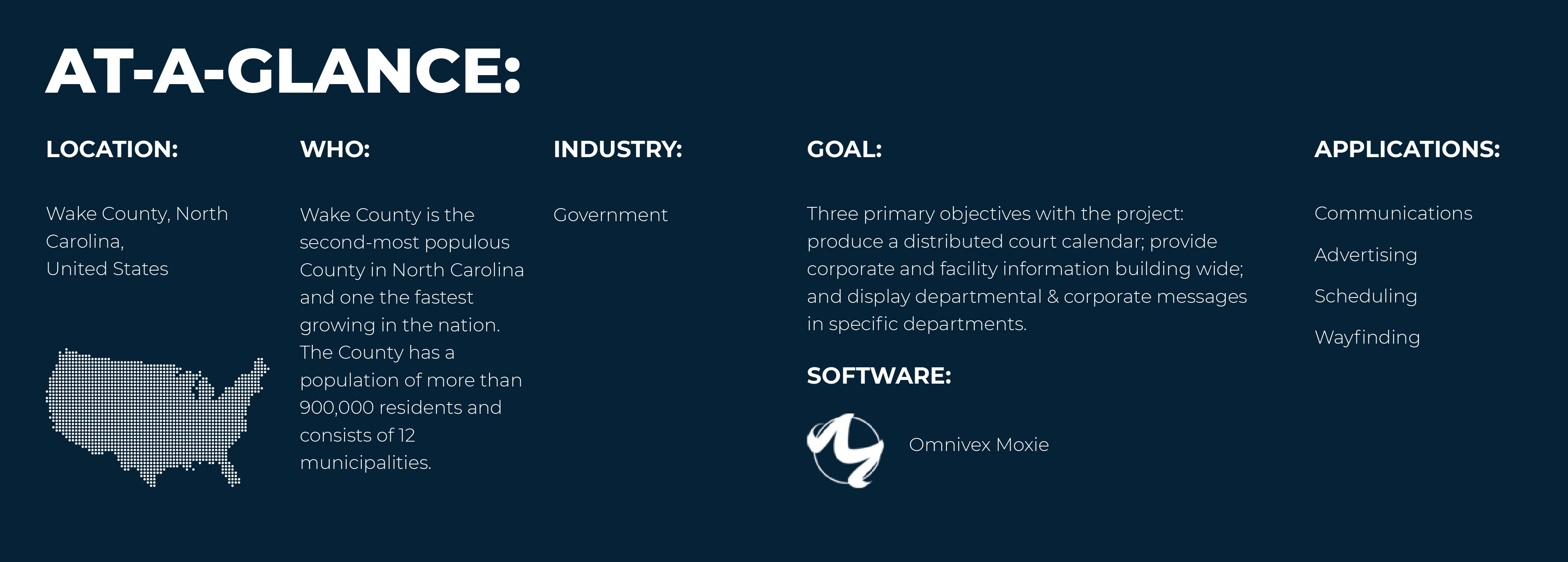
About Wake County
Wake County is the second-most populous County in North Carolina and one the fastest growing in the nation. The County has a population of more than 900,000 residents and consists of 12 municipalities, including Raleigh, the state Capital. Wake County is consistently rated as one of the best places to live and work in America and is home to NC State University, Research Triangle Park, and 2006 Stanley Cup Champions, the Carolina Hurricanes. It is also the center of state government with the Capitol Building, legislature and many government offices located in Raleigh.
The Scope
To keep pace with growth, Wake County government planned a new criminal court house and records building. The building, named the Justice Center, was designed with safety and customer service elements. To ease wayfinding Wake County planned a system of digital signage that would move the public through the building quickly and efficiently. Wake had three primary objectives with the project: 1) produce a distributed court calendar 2) provide corporate and facility information building wide and 3) display departmental messages in conjunction with the corporate messages in specific departments. Their situation was particularly complex because the courtroom data is managed by state government and changes constantly, so they needed a solution that would allow them to interface with the state system and provide scheduled and real-time updates to the screens in the courthouse.
To implement their plan they looked at other examples around the country and found two that they wanted to incorporate into their design. The first was an airport style display, in the lobby of a court house in Maryland that provided a scrolling view of the names of people on the court docket and the court room they were assigned to. The second example was in New York where a court house used screens outside of each court room to identify what was going on in the room. "Our priority was to make the building navigable and eliminate bottlenecks in order to speed justice" said David Goodwin, Director of Wake County's General Services Administration. Wake County's final plan was to create a network of screens throughout the building, including main entries, elevators, lobby areas, and in front of individual court rooms. These monitors would provide court calendar information upon entry and at each courtroom, corporate and facility information such as flu shots and blood drives and floor information, and departmental information that instructs the public on vital records and real estate transactions.
The Solution
Wake County selected Omnivex Moxie as the solution to power the 69 screens throughout their new court house building. The Omnivex solution offered Wake the ability to easily manage the complex court data and provide in the same system corporate and departmental messages. Working with their partner, Technical Innovation, Wake County was able to set up a wayfinding solution that shows what court cases are where during morning and afternoon sessions of court, all combined with relevant communications and local information from the county. Screens were used in combination with static signage to ensure people could get where they needed to go as efficiently as possible.
Since this new court house was being built by a contractor and the County wouldn't have system access until just prior to opening, it was important to find a way to develop the content before Wake received the system. To implement the solution Wake County created an advance team who worked with Omnivex and Technical Innovation to create a sand box environment that they could use as a research and development tool and to train staff. The advance team also collaborated to determine which content should be shown and how best to share the content across the new facility. This approach helped ensure a smooth transition when the building was completed by the contractor and the production system was turned over to Wake County in June 2013.
The Results
For Wake County one of the easiest ways to determine the success of the project was to see people walk up, look at monitors, find their court room and go there, with ease. "The speed with which people navigate the Justice Center is evidence that we accomplished our objective," said David Goodwin. The screens at entry scroll the courtroom number and person’s name; the screens at the courtroom show the cases in session, name of person, court room number, offence, and arresting officer. In addition to the court information people entering the building are able to easily find the offices of other departments in the facility, such as the tax department. The ability to change information on the fly has also been huge advantage for Wake County with constantly updating court information coming from the state. This ease of use has also been helpful within the building to change departmental content.
The facility is well received by the community and the signage is regularly credited as elevating and punctuating the building experience. The Omnivex signage has received a number of positive comments and accolades from the public and Wake County recently won an achievement award from the National Association of Counties for the installation. Wake County has set a new standard for public buildings and plans to further extend digital signage into other areas and venues in the county.
